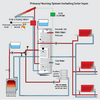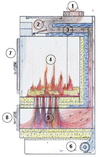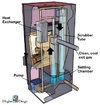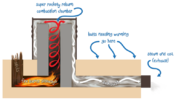Firstly, well done on finding a new vacant rental property. As IW says, check the EPC for comments. It is your right to see the full document.
If possible, ask to see the electric usage for the last twelve months. I note that the electric heater on photo 2 is a 'High Heat Retention' night storage heater, that helps the EPC score. Check the property has an E7 or E10 dual rate meter as the NSH charges up on the night (low) rate, so much the better if the meter is a radio time switch. You can set a room temperature in the NSH and it will do such. It effectively distributed heat by a fan sucking air through the hot core. On really cold days it may use day electric the heat the room. The fan uses peak rate electric to run, hence the two cables going to the heater.
The panel heater in photo 4 used peak rate electricity so will be more costly to run.
The log burner wouldn't worry me, do get a Sterling Engine Fan to sit on it - that will blow warm air away from the log burner when it heats up. A benefit of the log burner is it will cause an air flow reducing (maybe eliminating) damp in the property.
I'd not hang around worrying about the house but having found one at an affordable price in an area that suits you go for it. If the worst comes to the worst you have six months to find somewhere else but with so many LandLords getting out of the business it will only get harder.
Hi many thanks for your reply. Someone has told me i can download the full epc so i got it off the gov site, please see the above post. Thanks for spotting the heater models and their functionality, i will look to see if the have an off peak meter to benefit from this. I will also ask about the energy usage over the last year, from what the house listing says, the new heaters were fitted May 2023 just before the EPC was last done.
Thanks for the tips on the log burner too, worth using if it reduces my bills.
Yeah i was thinking the same, go for the house and hope for the best, the lack of gas heating might put other people off.
Hi mate thanks for your reply. I think the C rating rules are coming in the future.I thought the EPC had to be a C maximum on rentals?
Perhaps I'm wrong.
I would deffo use the log burner, as I have a pile of free wood in the garden. And loads more to trim. I now go round local skips and take timber off cuts or old studwork that's been ripped out. That's well seasoned and I won't have to wait for that to dry out.
The old oak joists are the best.
Thanks for the tips on the log burner, im more likely to buy bags of wood as im a lazy sod lol
Thick lined curtains will help a lot.
If you have cheap rate night electricity, you can use an electric heater in the bedroom overnight, though an electric blanket will be even cheaper to run.
Oil filled radiators give an even and comfortable heat, and are safer than ordinary convectors. Timers will help you put them on shortly before you need heat.
Storage Heaters are most suitable if you are at home all day and go to bed early.
Hi mate thanks for your reply. I will invest in thick lined curtains too. I need to check if it has an off peak meter of not. I have an electric blanket that i dont use so i can use it in the winter. Thanks for all the advice
I'm not sure that log burner would comply with building control, it seems too big for the opening and wouldn't be able to be ventilated properly. You could ask if its been signed off.
If you can source cheap wood, they are great at keeping a house warm. Does it have a gas boiler or is it all electric?
Thanks for the reply and advice mate. I will ask about the log burner, i did not know they had to be signed off so its worth asking.
I have posted the details from the epc report above, it only has electric immersion for hot water, no tank, electric shower.






